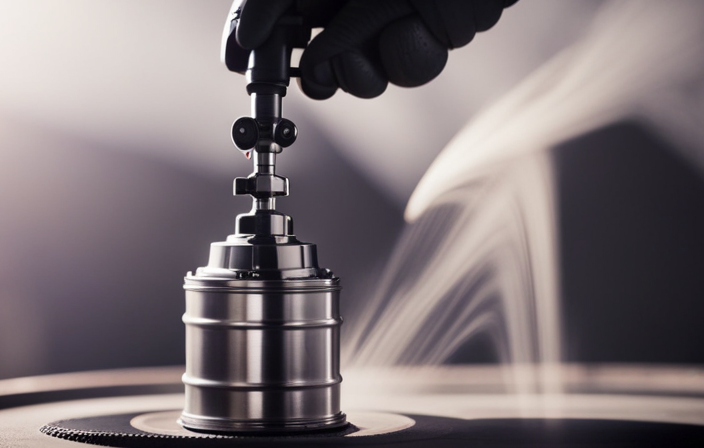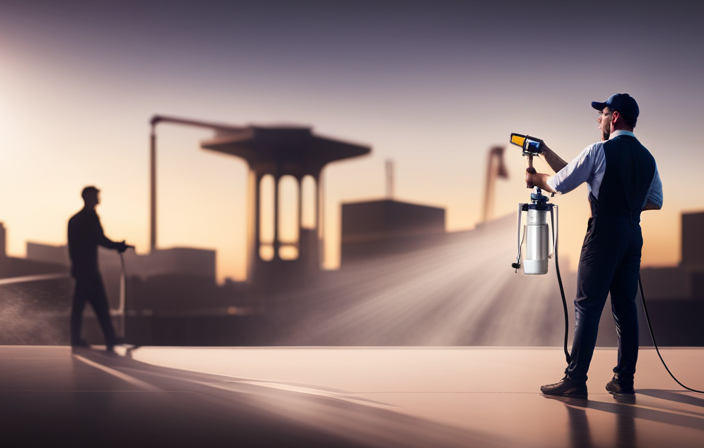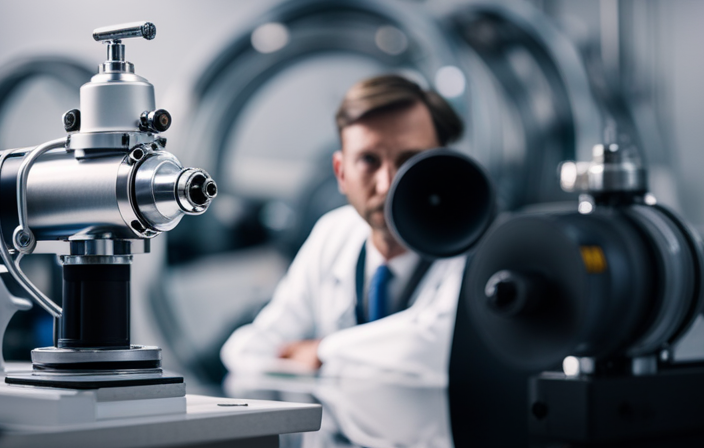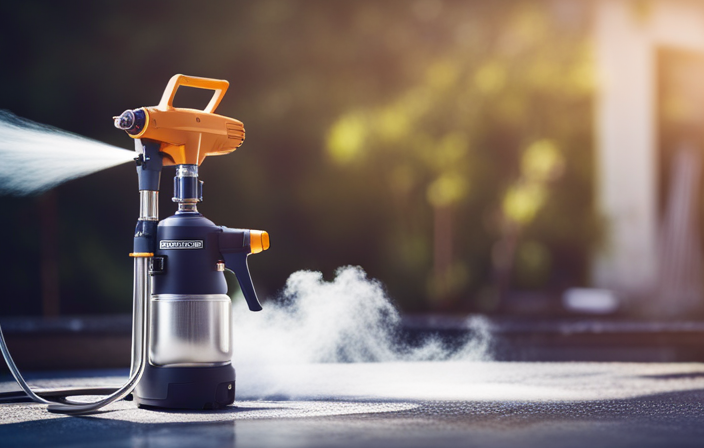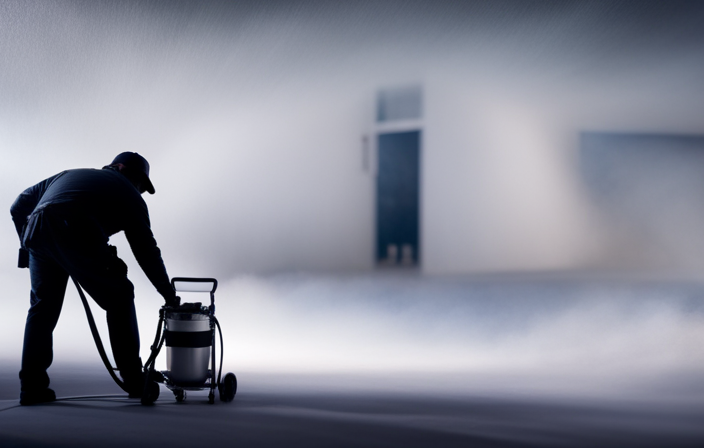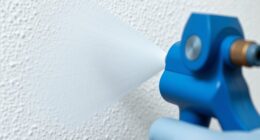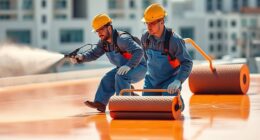Ever thought about what the top latex primer is for an airless paint sprayer? Well, look no further, as I’ve got all the details you need.
In this article, I will guide you through the importance of using a latex primer with an airless paint sprayer and help you understand which types of primers are compatible. Choosing the right latex primer is crucial for achieving a smooth and professional-looking finish on your painted surfaces. With my knowledgeable and detailed advice, you will be able to make an informed decision based on your specific needs and preferences.
I will also provide you with step-by-step instructions on how to prepare the surface for primer application and how to apply the primer using an airless paint sprayer. Additionally, I will share tips on sanding and prepping the primed surface for optimal results.
So, if you’re ready to take your painting projects to the next level, let’s dive in and discover the perfect latex primer to use with your airless paint sprayer.
Key Takeaways
- Water-based latex primers offer easy application, quick drying, excellent adhesion, durability, and resistance to mildew and moisture.
- Acrylic latex primers provide excellent adhesion, durability, resistance to mildew, a smooth and uniform surface, fast drying, and low odor.
- High-build latex primers are ideal for filling and smoothing rough surfaces, providing better coverage and hiding imperfections, with excellent adhesion.
- Choosing the right latex primer depends on considering the surface type and condition, using high-build primers for porous or imperfect surfaces, and standard latex primers for smooth and good-condition surfaces.
Understanding the Importance of Using a Latex Primer with an Airless Paint Sprayer
You need to understand why it’s crucial to use a latex primer with an airless paint sprayer. Proper surface preparation is crucial for achieving a flawless paint job. By using a latex primer, you ensure that the surface is properly sealed, allowing the paint to adhere better and last longer.
An airless paint sprayer is an excellent tool for applying paint evenly and efficiently, saving you time and effort. It provides a smooth finish and allows you to cover a large area quickly. When used with a latex primer, the benefits are even greater.
The primer helps create a strong bond between the surface and the paint, resulting in a more durable and professional-looking finish.
Now let’s explore the different types of latex primers compatible with airless paint sprayers.
Types of Latex Primers Compatible with Airless Paint Sprayers
When it comes to using an airless paint sprayer with latex primers, it’s important to understand the different types of primers that are compatible.
Water-based latex primers are a popular choice for their ease of use and quick drying time.
Acrylic latex primers, on the other hand, offer excellent adhesion and durability, making them ideal for high-traffic areas.
Lastly, high-build latex primers are designed to fill in and smooth out rough surfaces, providing a solid foundation for the paint to adhere to.
Water-Based Latex Primers
Using a water-based latex primer with an airless paint sprayer is like applying a smooth, comforting coat of lotion to dry, thirsty skin. Not only does it provide a strong foundation for the paint, but it also offers several benefits. Latex primers are known for their excellent adhesion, durability, and resistance to mildew and moisture. They also dry quickly, allowing you to move on to the painting process sooner. When applying latex primer with an airless paint sprayer, it is important to use the correct technique. Start by setting the sprayer to the recommended pressure and applying the primer in thin, even coats. Allow each coat to dry before applying another. This will ensure a smooth and flawless finish. Transitioning to acrylic latex primers, they offer even greater durability and adhesion, making them a popular choice for high-traffic areas.
Acrylic Latex Primers
Acrylic latex primers, with their superior durability and adhesion, are a popular choice for areas with high foot traffic. An acrylic latex primer is made with a water-based formula that contains acrylic resins. This type of primer has many benefits, including excellent adhesion to various surfaces such as drywall, wood, and previously painted areas.
It also provides a smooth and uniform surface for the topcoat, ensuring a professional finish. Additionally, acrylic latex primers are fast-drying and low in odor, making them convenient to use. They’re also resistant to mildew and can help prevent stains from bleeding through the topcoat.
When looking for a primer to use with an airless paint sprayer, an acrylic latex primer is a great choice. It provides a strong foundation for the paint and ensures long-lasting results.
Moving on to high-build latex primers, they offer even more benefits for specific painting projects.
High-Build Latex Primers
High-build latex primers, on the other hand, pack a punch with their added benefits for specific painting projects.
These primers are designed to provide a thicker coat, allowing for better coverage and hiding imperfections on the surface. One of the key benefits of using a high-build primer is its ability to fill in small cracks, divots, and other surface irregularities. This creates a smooth and even surface for the paint to adhere to, resulting in a professional-looking finish.
Additionally, high-build primers offer excellent adhesion to a variety of surfaces, including wood, drywall, and previously painted surfaces.
When applying a high-build latex primer, it’s important to follow a few tips for optimal results. First, make sure to thoroughly clean and prepare the surface before applying the primer. This will ensure proper adhesion and a smooth finish.
Secondly, consider using a roller or brush for application, as these tools allow for better control and coverage compared to using a sprayer.
Lastly, be sure to apply the primer in thin, even coats, allowing sufficient drying time between each coat.
Considering these benefits and application tips, it’s important to choose the right latex primer for your specific project.
Considerations for Choosing the Right Latex Primer
When choosing the right latex primer, there are several key considerations to keep in mind.
First, you need to consider the surface type and condition as different primers are designed for specific surfaces such as drywall, wood, or metal.
Next, think about your desired finish and coverage as some primers offer better adhesion and hiding power than others.
Lastly, consider the drying time and ease of application as these factors can greatly impact the overall efficiency and convenience of your painting project.
By taking these factors into account, you can ensure that you choose the best latex primer for your specific needs.
Surface Type and Condition
For a flawless finish, it’s crucial to consider the surface type and condition when choosing a latex primer for your airless paint sprayer. Proper surface preparation is key to ensuring that the primer adheres well and provides a smooth base for the topcoat.
Different surfaces may require different primers, so it’s important to choose a primer that is suitable for the specific surface you’re working on. If the surface is porous or has a lot of imperfections, you may need a high-build primer to fill in the gaps and create a smooth surface. On the other hand, if the surface is already smooth and in good condition, a standard latex primer should suffice.
By considering the surface type and condition, you can select the most appropriate primer for your project, which will ultimately contribute to a professional-looking finish.
Moving on to the next consideration, let’s talk about desired finish and coverage.
Desired Finish and Coverage
To achieve a flawless and professional-looking finish, it’s important to consider the type of surface and its condition when choosing the perfect primer for your project. The desired finish and coverage are crucial factors to keep in mind.
If you’re aiming for a smooth and even result, a high-quality latex primer is essential. This type of primer provides excellent adhesion, ensuring that your paint adheres well to the surface and creates a uniform appearance. Additionally, latex primers offer great coverage, effectively hiding any imperfections on the surface. When applied properly, they can create a solid base for your paint, resulting in a beautiful finish.
With the right primer, you can achieve the desired finish and coverage, setting the stage for a successful paint job.
Now, let’s move on to discussing the drying time and ease of application.
Drying Time and Ease of Application
Once you’ve chosen the perfect primer, you’ll be pleasantly surprised by how quickly it dries and how easily it applies, making your painting project a breeze. The drying time of a latex primer can vary depending on factors such as temperature and humidity, but in general, it dries faster than oil-based primers. This means that you can move on to the next step of your painting project sooner, saving you time and allowing you to complete the job more efficiently.
When it comes to application techniques, using an airless paint sprayer can make the process even easier. This tool allows for a smooth and even application of the primer, resulting in a professional-looking finish. It also saves time and effort compared to using a brush or roller. However, it is important to follow the manufacturer’s instructions for your specific airless paint sprayer to ensure proper application.
In the next section, we will discuss the importance of preparing the surface before applying the primer to ensure optimal adhesion and longevity of your paint job.
Preparing the Surface for Primer Application
When preparing the surface for primer application, there are three key points that should be considered: cleaning and sanding, filling and repairing imperfections, and taping and masking.
To ensure a smooth and durable finish, it’s important to thoroughly clean the surface of any dirt, grease, or loose paint. Additionally, sanding the surface will help to create a rough texture that allows the primer to adhere better.
Finally, filling and repairing any imperfections, such as cracks or holes, will ensure a seamless and professional-looking result. Taping and masking off areas that aren’t intended to be primed will also help to create clean lines and prevent overspray.
Cleaning and Sanding
Cleaning and sanding are essential steps before applying the latex primer with an airless paint sprayer. When it comes to cleaning, there are various techniques you can use depending on the surface you’re working on. For most surfaces, a mixture of warm water and mild detergent will do the trick. Make sure to remove any dirt, grease, or oil from the surface before proceeding.
As for sanding, you’ll need the right tools such as sandpaper or a sanding block. Sanding helps to smooth out any rough patches or imperfections on the surface, ensuring a smooth and even application of the primer.
Once you’ve thoroughly cleaned and sanded the surface, you can move on to filling and repairing any imperfections, ensuring a flawless finish.
Filling and Repairing Imperfections
To achieve a flawless finish, it’s crucial to address any blemishes or flaws on the surface by filling and repairing them. Here are some essential steps to consider when filling and repairing imperfections:
-
Start by inspecting the surface for any cracks or holes that need to be repaired.
-
Use a high-quality latex patching compound to fill in the cracks and holes.
-
Smooth out any textured surfaces by lightly sanding them with a fine-grit sandpaper.
-
Apply a second coat of patching compound if necessary, ensuring a smooth and even finish.
-
Allow the patched areas to dry completely before moving on to the next step.
By following these steps, you can ensure that your surface is ready for painting.
Now, let’s move on to the next section about taping and masking.
Taping and Masking
Get ready to achieve a professional-looking paint job by mastering the art of taping and masking! Proper surface preparation is crucial for a flawless finish, and using the right masking techniques is essential to ensure clean edges and protect surfaces that you don’t want to paint.
To properly tape and mask, start by cleaning the surface thoroughly to remove any dirt or debris. Next, apply painter’s tape along the edges of the areas you want to protect, making sure to press it firmly to create a tight seal. Use a putty knife or a straight edge to smooth out any air bubbles or wrinkles in the tape.
To add a level of sophistication to your taping and masking skills, consider using a table to keep track of your progress. Here’s an example of a 3 column and 4 row table:
| Area | Type of Masking | Notes |
|---|---|---|
| Windows | Blue painter’s tape | Remove tape after 24 hours to avoid adhesive residue |
| Baseboards | Paper masking tape | Press firmly to ensure a tight seal |
| Light fixtures | Plastic sheeting | Secure with painter’s tape for easy removal |
| Door frames | Masking film | Use a sharp utility knife for clean edges |
Now that you’ve mastered the art of taping and masking, it’s time to move on to the next step: applying latex primer with an airless paint sprayer.
Applying Latex Primer with an Airless Paint Sprayer
When using an airless paint sprayer, you’ll want to ensure a smooth application of latex primer by following these steps:
-
Start by preparing the surface you plan to prime. Clean it thoroughly and repair any imperfections.
-
Load the latex primer into the sprayer’s reservoir, making sure it’s mixed well and strained if necessary.
-
Adjust the sprayer’s pressure settings to achieve the desired spray pattern. Test it on a scrap surface to ensure it’s applying evenly.
-
Begin spraying the primer in a smooth, controlled motion, moving the sprayer from side to side and overlapping each pass slightly.
-
Keep a consistent distance from the surface, typically around 12 inches, to avoid uneven coverage.
-
Troubleshoot common issues such as clogging or uneven application by adjusting the pressure, cleaning the sprayer, or thinning the primer if needed.
After applying the latex primer with an airless paint sprayer, it’s important to understand the drying and curing time for latex primers.
Drying and Curing Time for Latex Primers
Achieve optimal results by understanding the drying and curing time of latex primers after application.
The drying time for latex primers can vary depending on factors such as humidity, temperature, and the thickness of the primer coat. Typically, latex primers dry to the touch within 30 minutes to an hour. However, it’s important to note that drying time doesn’t necessarily mean that the primer is fully cured.
The curing process for latex primers can take anywhere from 24 hours to several days. During this time, the primer undergoes a chemical reaction that strengthens its bond to the surface and ensures proper adhesion of the paint.
It’s crucial to allow the primer sufficient time to fully cure before proceeding with the next steps, such as sanding and prepping the primed surface for painting.
Sanding and Prepping the Primed Surface
To ensure a smooth and flawless painting surface, you’ll want to make sure to properly sand and prepare the primed surface. Proper sanding techniques are crucial to achieving a professional finish.
Start by using a medium-grit sandpaper to gently sand the surface, focusing on any rough patches or imperfections. Be sure to sand in a circular motion to avoid creating visible scratches.
Afterward, switch to a fine-grit sandpaper to smooth out the surface even further. This will help the topcoat adhere better and result in a more even finish.
When choosing the right sandpaper, opt for a higher grit number for a smoother finish.
Once the primed surface is sanded and prepped, you can move on to choosing the right latex paint for the topcoat.
Choosing the Right Latex Paint for Topcoat
Now that we’ve properly prepped the primed surface by sanding it down, it’s time to move on to the next step: choosing the right latex paint for the topcoat.
This is a crucial decision as it’ll determine the final outcome of our project. When selecting a latex paint, it’s important to consider its compatibility with the primed surface and the airless paint sprayer. Look for a paint that’s specifically labeled for use with airless sprayers and is compatible with the type of primer you’ve used. This will ensure smooth application and optimal adhesion.
Additionally, consider factors such as the desired finish, durability, and color options.
With the right latex paint selected, we can now move on to applying it with the airless paint sprayer.
Applying Latex Paint with an Airless Paint Sprayer
With the right paint and a powerful tool in hand, let’s unleash the magic of the airless paint sprayer to transform our surface into a work of art. When applying latex paint with an airless paint sprayer, there are a few important things to keep in mind.
First, it’s crucial to dilute the latex paint with water according to the manufacturer’s instructions. This will ensure that the paint flows smoothly through the sprayer and provides an even coat on the surface.
Additionally, it’s important to troubleshoot any issues that may arise with the airless paint sprayer, such as clogs or inconsistent spray patterns. Regular maintenance and cleaning of the sprayer will help prevent these problems.
Finally, when finished with the painting project, proper cleaning and storage of the sprayer will ensure its longevity. Moving on to finishing and cleaning up, let’s make sure we leave our workspace tidy and ready for the next project.
Finishing and Cleaning Up
Make sure you tidy up your workspace and leave it ready for the next project, so you can fully enjoy the satisfaction of a job well done. Cleaning up after using an airless paint sprayer is an important step to maintain its longevity and efficiency. Here are some cleaning techniques and best practices to follow:
-
Flush the sprayer: Start by emptying any remaining paint from the sprayer. Then, fill the paint cup with water or a cleaning solution recommended by the manufacturer. Run the sprayer until clear water comes out, ensuring all paint residue is removed.
-
Disassemble and clean: Take apart the spray gun, nozzle, and filters. Clean them thoroughly using a brush and the cleaning solution. Pay close attention to removing any clogs or dried paint.
-
Store properly: After cleaning, make sure to store the sprayer and its components in a clean and dry place to prevent any damage or contamination.
By following these cleaning techniques and best practices, you can maintain the performance of your airless paint sprayer and ensure it is ready for your next painting project.
Frequently Asked Questions
Can I use a latex primer with a traditional paintbrush instead of an airless paint sprayer?
Using a traditional paintbrush with latex primer instead of an airless paint sprayer is like trying to change a tire with a spoon. It’s possible, but not efficient. Pros of using an airless sprayer include faster coverage and a smoother finish, while cons include the need for equipment and overspray.
Are there any special precautions I need to take when using a latex primer with an airless paint sprayer?
When using a latex primer with an airless paint sprayer, it is important to take certain precautions. Ensure proper ventilation, wear protective gear, and maintain the correct spraying distance for smooth and even coverage.
Can I use a latex primer on surfaces that have already been painted with oil-based paint?
Yes, you can use a latex primer on surfaces previously painted with latex paint. It offers several benefits over an oil-based primer, such as better adhesion, flexibility, and easier clean-up.
How long should I wait before applying a topcoat of latex paint after priming with a latex primer?
Ah, the eternal question of how long to wait before applying a topcoat of latex paint after priming with a latex primer. Well, my dear friend, the answer lies in the stars, or rather, the instructions on the primer can. Follow them religiously, for they hold the wisdom you seek.
Is it necessary to sand the primed surface before applying a topcoat of latex paint?
Sanding the primed surface before applying a topcoat of latex paint is not necessary, but it has several benefits. Sanding smooths out imperfections, improves adhesion, and helps achieve a smoother, more professional-looking finish.
Conclusion
In conclusion, using a latex primer with an airless paint sprayer is crucial for achieving a smooth and durable finish on any surface. It ensures better adhesion and enhances the topcoat’s color. Additionally, it increases the paint’s longevity. Interestingly, studies have shown that using a latex primer can increase the lifespan of a paint job by up to 50%. So, investing in a high-quality latex primer and properly applying it with an airless paint sprayer is definitely worth the effort for a professional-looking result.
